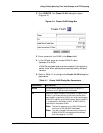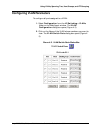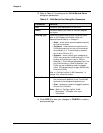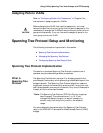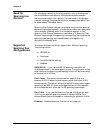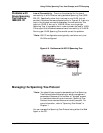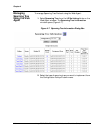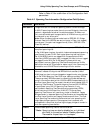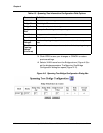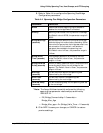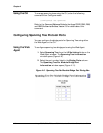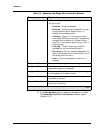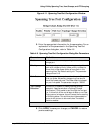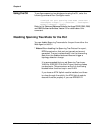
Avaya P550R, P580, P880, and P882 Multiservice Switch User Guide, Version v5.3.1 4-17
Using VLANs, Spanning Tree, Hunt Groups, and VTP Snooping
Refer to Table 4-3 for a definition of the Configuration field
parameters:
Table 4-3. Spanning Tree Information Configuration Field Options
Parameter Definition
IEEE 802.1D Single IEEE 802.1D-compliant spanning tree for the entire bridge.
In 802.1D spanning tree mode, there is one root Bridge for the whole
network, regardless of whether the switches support VLANs or not.
Only one active data path is supported for all VLANs from any point in
the network to any other point
Note: When the spanning tree mode is set to IEEE 802.1D, Bridge
Protocol Data Units (BPDUs) are sent out ports in Clear (non-tagged)
format even if the port has a tagged format (3Com, IEEE 802.1Q or
Cisco ISL) defined.
Per VLAN (Default Switch Setting) Each VLAN runs a separate IEEE 802.1D-
compliant spanning tree.
In Per-VLAN spanning tree, the switch implements a separate spanning
tree Domain for each VLAN. Each logical spanning tree has its own
Per-VLAN BPDU’s which are tagged with the appropriate VLAN
identifier(s).BPDU’s are sent clear (untagged) on clear trunks or tagged
on tagged trunks. With Per-VLAN spanning tree a switch can
participate in as many Spanning Tree Domains as there are VLANs
defined on the switch.This allows for better use of links. Some may be
blocked for one VLAN STP and forwarding traffic for another.
Dual Layer Dual-Layer spanning tree is a variation of per-VLAN spanning tree.
However, instead of using normal BPDUs which are clear (free of
VLAN tags) on clear trunks and tagged on tagged trunks, as is the case
with Per-VLAN Spanning Tree. Dual-layer uses a proprietary BPDUs.
These proprietary BPDUs are sent to a special multicast address and
contain information about which VLAN the BPDU is associated with.In
the Dual-Layer Spanning Tree model, the switch terminates all 802.1D
Spanning Tree Domains. The switch does not forward 802.1D BPDUs
or participate in any 802.1D Spanning Tree Domains. It only
participates in Spanning Tree Domains using a proprietary BPDU,
which contains a VLAN identifier (VLAN ID). This proprietary
Spanning Tree Protocol will resolve any loops in the switch. Legacy
Bridges remain in separate Spanning Tree domains yet Loops between
the Dual Layer Domains and Legacy domains cannot form. The Dual-
Layer Spanning Tree method is preferred when inter-operating with
large legacy bridge networks. Convergence time is reduced, and
management is simplified, by allowing the legacy bridges to remain in
their own spanning tree domain.
Disable Global disable Spanning Tree for the entire switch.
* Note: Spanning tree can also be disabled on an individual
port.Refer to the section labeled Disabling Spanning
Tree mode for this port later in this chapter.
Bridge Indicates a Bridge instance, in the figure a STP bridge per-VLAN



